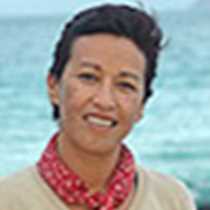Puerto Villamil on Isabela Island
The morning was nice, though a little bit cloudy. We all got ready to start our day with the first group going out for the hike to Sierra Negra Volcano. This is one of the most active volcanoes in the Galápagos, and has the second largest caldera in the world. We were headed to the northeastern slope where there are very young lava flows with active-steaming fumaroles.
The second and third group of guests went to visit the tortoise rearing center just outside the town of Villamil, where we learned about these very interesting creatures that have developed gigantic sizes on islands and actually gave these islands the name “Galápagos.” Tortoises are fearless creatures and good to eat and because of this, their populations have been decimated. They were captured first by pirates and buccaneers, then by whalers and settlers for their meat and oil. They were used by the settlers as barter in exchange them for flour and sugar and other items and this exploitation brought close to extinction.
The Galápagos National Park officers and Charles Darwin Research Station scientists are trying to increase the tortoise populations by reproducing them in captivity. The baby tortoises are raised until they are big enough to be repatriated to their islands of origin. There were originally fourteen different subspecies of giant tortoises in Galápagos; three of these are already gone. There is a sole survivor, Lonesome George, from the northern island of Pinta Island, and the tortoises from southern Isabela are considered endangered.
After our visit to the tortoise breeding center, we walked along a boardwalk towards the coralline beach. We hiked through the arid and littoral area vegetation and were welcomed to the beach by semi-palmated plovers, sanderlings and the rarest gull in the world the, lava gull (see today’s picture). There are only approximately 400 pairs of these gulls in the islands.
In the afternoon we enjoyed a visit to Las Tintoreras trail. Here we saw many baby iguanas, a single white-tipped reef shark and an enormous marbled stingray. Sea lions played in the wakes of the Zodiacs and a group of 20 penguins were sun bathing on the volcanic basaltic rocks. Some of our guests went for a bicycle ride or a walk around town and a group of us boarded a pick up truck taxi for a pretty drive along the coast to the Wall of Tears. This impressive rock structure was built by prisoners, between 1946-1957, while this island was used as a penal colony.
At the end of the day we all gathered for beer, colas and delicious sea food snacks at La Choza Restaurant. Then we came back aboard and enjoyed a presentation about the children’s conservation clubs of Isabela. After dinner we went to bed dreaming on the spectacular things that are awaiting us tomorrow.
The morning was nice, though a little bit cloudy. We all got ready to start our day with the first group going out for the hike to Sierra Negra Volcano. This is one of the most active volcanoes in the Galápagos, and has the second largest caldera in the world. We were headed to the northeastern slope where there are very young lava flows with active-steaming fumaroles.
The second and third group of guests went to visit the tortoise rearing center just outside the town of Villamil, where we learned about these very interesting creatures that have developed gigantic sizes on islands and actually gave these islands the name “Galápagos.” Tortoises are fearless creatures and good to eat and because of this, their populations have been decimated. They were captured first by pirates and buccaneers, then by whalers and settlers for their meat and oil. They were used by the settlers as barter in exchange them for flour and sugar and other items and this exploitation brought close to extinction.
The Galápagos National Park officers and Charles Darwin Research Station scientists are trying to increase the tortoise populations by reproducing them in captivity. The baby tortoises are raised until they are big enough to be repatriated to their islands of origin. There were originally fourteen different subspecies of giant tortoises in Galápagos; three of these are already gone. There is a sole survivor, Lonesome George, from the northern island of Pinta Island, and the tortoises from southern Isabela are considered endangered.
After our visit to the tortoise breeding center, we walked along a boardwalk towards the coralline beach. We hiked through the arid and littoral area vegetation and were welcomed to the beach by semi-palmated plovers, sanderlings and the rarest gull in the world the, lava gull (see today’s picture). There are only approximately 400 pairs of these gulls in the islands.
In the afternoon we enjoyed a visit to Las Tintoreras trail. Here we saw many baby iguanas, a single white-tipped reef shark and an enormous marbled stingray. Sea lions played in the wakes of the Zodiacs and a group of 20 penguins were sun bathing on the volcanic basaltic rocks. Some of our guests went for a bicycle ride or a walk around town and a group of us boarded a pick up truck taxi for a pretty drive along the coast to the Wall of Tears. This impressive rock structure was built by prisoners, between 1946-1957, while this island was used as a penal colony.
At the end of the day we all gathered for beer, colas and delicious sea food snacks at La Choza Restaurant. Then we came back aboard and enjoyed a presentation about the children’s conservation clubs of Isabela. After dinner we went to bed dreaming on the spectacular things that are awaiting us tomorrow.




